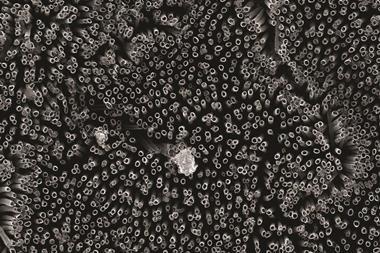Mystery of bouncing droplets that apparently defy the laws of physics unravelled
Tom Schutzius admits that when he first saw water droplets spontaneously levitate, bounce and then leap even higher, he was shocked at their apparent defiance of physical laws. But along with fellow members of Dimos Poulikakos’ team at the Swiss Federal Institute of Technology in Zurich, Schutzius has worked out what was causing this previously-unknown ‘trampolining’.

Rather than a trampoline, the droplets bounce on a grid of microscopic silicon pillars coated with a Teflon-like material to make an extremely water-repellent superhydrophobic surface. Water that initially sat on these surfaces levitated as the researchers progressively reduced the pressure surrounding them, creating a vacuum. ‘We’re working with extremely artificial lab conditions, but it’s an example of what surface engineering can do for you,’ Schutzius underlines. ‘If you can bring something like this to a real-world condition, it would be a very interesting phenomenon to exploit for anti-icing surfaces.’
The strange behaviour arises because superhydrophobic surfaces do exactly the opposite of what Schutzius had wanted. The channels between the coated silicon pillars and underneath the droplets trap air, and he was using vacuum to try to suck that air out – unsuccessfully. The air remained stubbornly reluctant to move, but something else was happening: water was boiling off from the droplets’ edges. ‘It starts to evaporate from anywhere that there’s a liquid–air interface, including into this open-pillared structure,’ Schutzius explains.
Because water vapour at the bottom of the droplet was blocked in by the air trapped underneath, pressure built up below it. ‘At a certain point, when this pressure gets too high, the droplet just jumps spontaneously off the surface,’ Schutzius says. As he lowered the surrounding pressure further, the evaporation sped up, pressures between the droplet and surface grew, and they bounced higher.
Ups and downs
The connection to ice comes because as water boils off it supercools the rest of the droplet below its normal freezing point. But when the water does eventually turn into ice its temperature increases to 0°C. That temperature rise triggers a sudden increase in vaporisation, boosting the levitation process and spontaneously removing icy drops from the surface at the moment they freeze.
By designing the surface with shorter pillars that minimise water vapour flow the Swiss team was also able to ensure that certain droplet sizes trampolined practically every time. Using this design, they put a lever on top of a trampolining droplet to create a device that moves continuously and could become a means of generating power.
‘This beautiful phenomenon shows how drop impacts continue to be surprising,’ comments Julia Yeomans from the University of Oxford, UK, who investigates such impacts but wasn’t involved in this study. ‘In the past few years we have seen droplets that leave a surface when they coalesce, bounce in a pancake shape, run around ratcheted tracks and mimic quantum particles. Next, an important goal for this research should be to translate it from the lab to real-world applications to improve stay-dry and anti-icing surfaces.’
This is a significant challenge, Schutzius stresses, in particular as it’s difficult to produce materials that are sufficiently water-repellent. ‘Superhydrophobic surfaces are not used in many applications yet because they may not be durable enough, so a lot still needs to happen on the materials side,’ he says. However, the Zurich team’s first priority will be exploring the trampolining effect in different contexts. ‘One obvious next step would be to make the surface more water repellent, or can you make it even more difficult for vapour to drain through the surface texture, so you build up pressure more easily?’ Schutzius asks.
References
T M Schutzius et al, Nature, 2015, DOI: 10.1038/nature15738












No comments yet